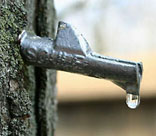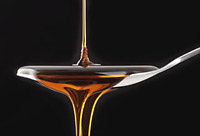| |
 |
 |
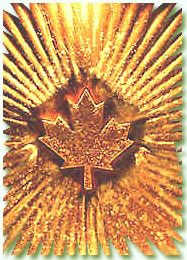 It's Maple syrup time! It's been really cold and maple producers are gearing up and will do their best to provide wonderful maple sugar production. Latest conditions will be given for many of the sites below and conditions vary from area to area. It's Maple syrup time! It's been really cold and maple producers are gearing up and will do their best to provide wonderful maple sugar production. Latest conditions will be given for many of the sites below and conditions vary from area to area.
Spring fever warms the air and also brings another kind of March madness. Before sugar maple buds open, the tree needs nutrients found in sap. Below-freezing nights and sunny, warm (40 degrees F) days provide optimal conditions for sap to start moving up the tree, possibly draining into a bucket or through a network of tubes to a sugarhouse, where it is evaporated over roaring fires and transformed into a regional delicacy sought round the world--Maple Sugar.
Begin your maple excursion with the annual Maple Weekend in New York, (March 21-22 & 28-29, 2020 10 a.m.-4 p.m.) sponsored
by the New
York State Maple Producers Association (a consortium of
550+ maple producers throughout
the state) in an area nearby. Maple sugar producers host special open houses to demonstrate the art
of making maple syrup. This site provides nice starting points
for learning more about the production and use of maple syrup. Another great site to visit is from the University of Vermont. It offers a comprehensive collection of resources on the entire maple syrup industry and includes history, science, agriculture, and economic materials.
Sugar maple (Acer saccharum) is the most common maple species in New York. Maples provide the brilliant red autumn leaves, and in spring 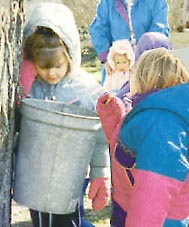 further stimulate our senses with maple syrup derived from their sap. This leaves little wonder why the sugar maple is New York's official state tree and appears in the center of the Canadian flag. further stimulate our senses with maple syrup derived from their sap. This leaves little wonder why the sugar maple is New York's official state tree and appears in the center of the Canadian flag.
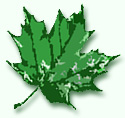 If you clicked on the "Maple syrup time" link above, you can listen to Pete Seeger singing the song live here. If you clicked on the "Maple syrup time" link above, you can listen to Pete Seeger singing the song live here.
What's News...
- Book: Maple Syrup: Over 75 Farm-Fresh Recipes. Hobart, NY: Hatherleigh Press, 2011 (ISBN: 9781578263691). From the series: Farmstand Favorites, this book contains recipes for a variety of meals and treats. It also includes information on a variety of syrups, where they are produced, and the best times and places to look for specific varieties and information on local farming and farmstand organizations."
- Maple Weekend March 21-22 & 28-29 10:00 a.m.-4 p.m. at Buffalo Niagara Heritage Village. "Featuring a lumberjack breakfast (seating promptly at 9:30 AM and 11:00 AM only), maple science demonstrations (tree science, leaf reading and pressing, soil testing, tree medallions, and art corner), and a new maple sugar tour led by Maple Sugar experts and our oxen, Jack and Flynn. Museum and Historic Village will be open with demonstrations by costumed interpreters, the Woodwrights Guild, and the NYS Designer Blacksmiths."
- Maple Syrup: Nature's Nutrient-Rich Sweetner. A short article on the benefits of maply sugar. Turn to page 9.
- Maple-inspired music: View fiddler Ward Allen playing Maple Sugar, and then listen to the Maple Sugar Polka.
- Maple Sugar Festival. Saturdays & Sundays, March 21-22 & March 28-29. Genesee Country Village & Museum. Sugaring program 9:30 a.m.-4 p.m. /
Breakfast 9 a.m.- 1 p.m. "Celebrate this special time at the museum in March with a Pancake Breakfast, self-guided walks to the sugar bush, 19th-century and modern syrup-making demos and tastings.
The entire museum will be alive with activities—including hands-on crafts, games, food tastings, dancing, open-hearth cooking in our historic village, a maple cooking contest, a maple sugar history trail and even brewing up some maple beer.
Maple-sugaring activities including log hewing, spile carving, tree tapping, sap collection and boiling down the sap to syrup and sugar. Visit the cooper and tinsmith as they make buckets for collecting sap.
- The Other Syrup: Why Birch is the Hot New Flavor (Adirondack Life Magazine Mar./Apr. 2014). Alternative competition for maple sugar.
- Recipes! Brand-new ideas in the Recipes section.
|
| |
 |
| |
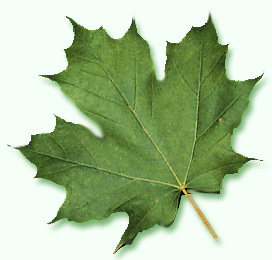 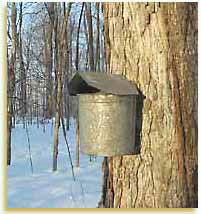 Obtaining
the raw material for maple syrup results of physiological processes
that turn each tree into an osmotic pump. Steve Vogel ("Nature's Pumps" American Scientist 82,
September-October 1994) describes the movement of ions across cell
membranes allowing a concentration gradient to be maintained where, "a
mere one-molar concentration difference generates over one million pascals, so an osmotic pump can easily work against quite a high
resistance." Obtaining
the raw material for maple syrup results of physiological processes
that turn each tree into an osmotic pump. Steve Vogel ("Nature's Pumps" American Scientist 82,
September-October 1994) describes the movement of ions across cell
membranes allowing a concentration gradient to be maintained where, "a
mere one-molar concentration difference generates over one million pascals, so an osmotic pump can easily work against quite a high
resistance."
As the daytime temperature begins to rise, starch accumulated during the previous summer and stored over the winter in the tree's zylem parenchyma is hydrolyzed by special "contact cells." Hydrolyzed starch products include the sugar, sucrose, which can reach concentrations of 3-5%. The osmotic pump is "primed" with the high concentration of sugars dissolved in the maple tree's large plumbing network of phloem. Water drawn into the trees by its root system provides the sugary sap that can travel at the rate of 1m/hr. The maple tree is "tapped" to
capture the flow and provide the sap for maple syrup.
The sap obtained from the maple tree is a clear, colorless, sterile liquid providing the water and nutrients for the tree's buds. The North American Maple Syrup Producers Manual "Appendix 2: Chemistry and Quality"
provides a chemical analysis of sap: 98+% sucrose, < 2.0%
glucose, phenolic compounds, amines, peptides, amino acids, proteins,
and organic acids. It takes about 40 gallons of sap to produce one
gallon of maple syrup, which weighs about 11 pounds and has a 66.5% sugar content.
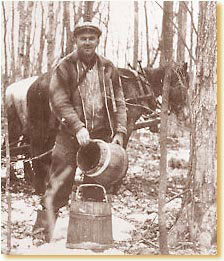 Maple sugaring (producing syrup from sap) was shown to the first European settlers to the Americas by native Indian tribes and involves a variety of scientific and technical concepts: levers (splitting firewood), heat transfer, viscosity, boiling point, and depression of freezing points are among the concepts of physics involved in transforming the watery sap to a thick, rich, amber syrup. Larry R. Yoder's The Physics of
Maple Syrup Making
is a good starting point for learning the science behind the process. Maple sugaring (producing syrup from sap) was shown to the first European settlers to the Americas by native Indian tribes and involves a variety of scientific and technical concepts: levers (splitting firewood), heat transfer, viscosity, boiling point, and depression of freezing points are among the concepts of physics involved in transforming the watery sap to a thick, rich, amber syrup. Larry R. Yoder's The Physics of
Maple Syrup Making
is a good starting point for learning the science behind the process.
For events and activities in the Western New York/Southern Ontario region go directly to:
- Maple Weekend in New York
March 21-22 & 28-29, 2020.
- Maple Weekend March 21-22 & March 28-29 9:30 a.m.-4 p.m. at Buffalo Niagara Heritage Village. "Featuring a lumberjack breakfast (seating promptly at 9:30 AM and 11:00 AM only), maple science demonstrations (tree science, leaf reading and pressing, soil testing, tree medallions, and art corner), and a new maple sugar tour led by Maple Sugar experts and our oxen, Jack and Flynn. Museum and Historic Village will be open with demonstrations by costumed interpreters, the Woodwrights Guild, and the NYS Designer Blacksmiths."
- Ontario Maple Sugar Producers Association lists local events and activities.
- or view links to other Regional Sugarbushes.

|
| |
 |
| |
Regional Sugarbushes -- Places to See and Taste Maple Sugaring
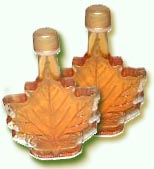 New York State Maple Producers Association provides map listings for participating maple syrup producers (search by zip code). Results show a map of your area with locations and names for each producer. New York State Maple Producers Association provides map listings for participating maple syrup producers (search by zip code). Results show a map of your area with locations and names for each producer.
- Ohio Maple Producers Association. History, tours, data, and other resources on sap production to syrup and sugar.
- Vermont Maple Sugar Makers' Association.
- Proctor Maple Research Center. Virtual tour of maple research at the Underhill Center, University of Vermont.
- RoundTheBend Online Travel Guide. Tourist treasure chest for New York State travel. Sites for Maple sugaring include:
- RocWiki (Rochester, NY). Links to maple sugaring in counties around Rochester.
- Maple Sugaring Weekends (Cumming Nature Center, Rochester Museum & Science Center, Naples, NY).
March 21–22 and March 28–29, April 4. See, taste, eat, learn.
- Maple Festival at Sweet Wind Farm. The 10th annual event is on March 12, in East Harland, CT. Also nearby, the Sharon Audubon Center has its big day on March 19. Syrup festivities are also planned at the New Canaan Nature Center on March 19. Pancakes will be served. Click here for a list of more Connecticut sugar houses.

|
| |

|
| |
 Maple Sugaring Science Maple Sugaring Science
Science (Chemistry and Production)
- Chemical Composition of Maple Syrup" David W. Ball Journal of Chemical Education, vol. 84, Issue 10, p.1647-1650.
- Molecular Models of Compounds in Maple Syrup, William F. Coleman Journal of Chemical Education, vol. 84, Issue 10, p.1650.
- Identifying Maple Trees for Syrup Production (Univ. of Minnesota). Guide to identify the maple trees
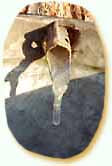 best suited for syrup production. best suited for syrup production.
- Maple Publications (Cornell Sugar Maple
Research & Extension Program). Articles on the science and production of maple sugar. Includes:
- Maple Sugaring Spring Phenology (Journey North). Participate in the Maple Sugaring Study (January to June). Print the chart and record the date each event occurs. Be sure to check and contribute to other Signs of Spring on the home page: Track Spring's Journey North!
- Hobby Maple Syrup Production (Ohio State University Factsheet F-36-02). Good document for beginning or veteran small-scale maple sugar producers.
- Tap My Trees. Make it yourself! Making maple syrup at home: a starter kit.
- How to Tap Maple Trees and Make Maple Syrup (University of Maine, Cooperative Extension).
- Massachusetts Maple Producers Association. Resources on every aspect of maple sugar and syrup production, including how products are made, where to locate local producers, science, events, recipes, and other materials. Also featured is a "do-it-yourself" article so you can try maple syrup production at home see: Make Your Own Syrup.
- Vermont Maple Syrup.
- Proctor Maple Research Center (Univ. of Vermont).
- The Physics of Maple Sugar Making. 1999 paper (updated 2013) by Larry R. Yoder.
- International Maple Syrup Institute. Who would guess, but it's no surprise there is an international organization.
- What Happens If Maple Trees Are Not Tapped? Find out in this interesting NPR report from 2005 on New England Suffering Maple Woes (warning: listen carefully before you panic).
- Intercomparison of sugar maple (Acersaccharum Marsh.) stand transpiration responses to environmental conditions from the Western Great Lakes Region of the United States. How does the environment affect sugar maples?
Quick Maple Facts
- 35-45 gallons of sap = 1 gallon of syrup
- Sugar content of sap = 2%-3%
- Sugar content of syrup = 66.5%
- Number of taps per tree = 1-3
- Number of taps per gallon of syrup = 3-4
- 20 gallons of syrup = 1 cord wood burned
- 1 gallon of syrup = 11 pounds
- 1 gallon of syrup yields = 7-8 lbs of maple sugar

|
| |
|
| |
 Background and History of Maple Sugaring Background and History of Maple Sugaring
- Sugar Maple (Acer saccharum) Tree identification sheet.
- Acer saccharum: Sugar Maple is a U.S. Forest Service fact sheet on the life history of the sugar maple tree. Fact Sheet 51, 1993 (University of Florida, Environmental Horticulture).
- Acer saccharum Fact Sheet. Photo identification and description.
- How Much Do You Know About Maple?
Facts and information list.
- International Maple Syrup Institute (IMSI).
A nonprofit organization by Canadian maple syrup interests established in 1975 to provide a worldwide network for exchanging information, expertise, and resources that promote pure maple syrup and related products. Be sure to check the Resources tab for a list of downloadable resources, including links to maple syrup standards from around the world.
- Introduction to
the History of Maple Syrup Production & the Maple Production Narrative from Cornell Unhttp://www.internationalmaplesyrupinstitute.com/downloadable-resources.htmliversity's Sugar Maple Research and Extension Program, linking to publications, other websites, and educational resources and activities. Also see: Life of a Sugar Maple Tree.
- Maple Syrup (University of Vermont). Comprehensive subject guide on all aspects of maple syrup making. Includes: history, collection and production, marketing, nutrition and recipes, sugar maple cultivation, environmental issues and pests and diseases.
- Maple History. Resources from the Massachusetts Maple Growers Association. General information, regional tours and educational resources
are included.
- Maple Sugar Glossary. All the terms you will need to speak "maple sugar" (e.g., doodlebug).
- Maple Syrup Production Report (Ontario Ministry of Agriculture and Food). Ontario maple sugar production. Informative updates on current production, with great photos of activities.
- Ohio Maple History (Ohio Maple Producers Association). Includes a short table of production facts.
- Pure Canadian Maple Syrup (Federation of Quebec Maple Syrup Producers). Everything on maple syrup and sugar production, including Benefits of Maple Sugar, How Maple Syrup is Made,
Recipes and uses, and more.
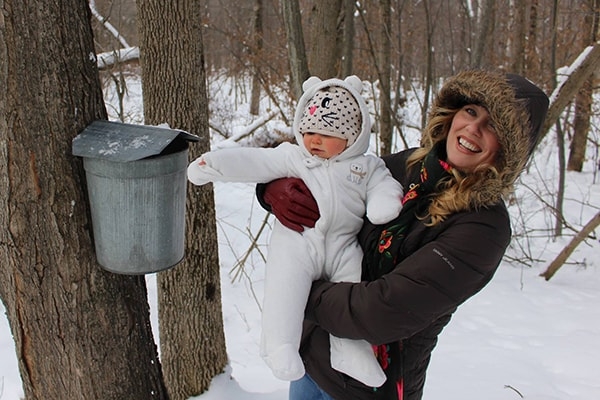
- More Than Maple Syrup (Educated Chemist (Royal Society of Chemistry)). On Canadian maple products (history, economics, science)
- Michigan Maple Syrup Association.
Comprehensive resources for the commercial sugarbush manager and the hobbyist, as well as history, kids' activities, and other materials.
- History of Maple Syrup. The Algonquians are one group credited with discovering maple syrup.
Also read: Native American Maple Tree Mythology.
For a list of State Trees and Flowers of the United States, visit the United States National Arboretum page.
Books
- Maple Sugar: From Sap to Syrup the History, Lore, and How-to Behind This Sweet Treat (9781603427357).
By Tim Herd.
Nice-sized book that covers all aspects, including history, maple tree identification, alternate sources of tree sugar, science, how to tap your own, recipes, and more.
- Book: The Sugarmaker's Companion: an Integrated Approach to Producing Syrup, from Maple, Birch, and Walnut Trees (9781603583978). Published in 2013, this work is a textbook for maple producers, from backyard, through large operation. It contains chapters covering all aspects of the process and includes science and technology. There is a good bibliography of the primary works on tree-sugar production, as well as a list of web resources. See a description at Amazon.
Education Materials
|
 |
| |
 |
|
| |
 Recipes with Maple Syrup Recipes with Maple Syrup
There are so many things to do with maple syrup! Here are a few sites telling you what can be done with them! Though you know that it is good for you, read the official document: Maple Sugar's Nutritional Value (USDA Nutrient Database for Standard Reference, Release 13). Read also the Nutritional Value of Maple Syrup. Brief description of the benefits of eating this wonderful food.
The products listed here are not endorsed by the authors. We add them to show a variety of unusual items that you may find interesting. Most of the state associations listed above have links to where to buy. See also the recipe section for additional sources.
- Lamothe's Sugar House (Burlington, CT). Come see maple sugaring any weekend in February or March (call ahead to verify it's a good day). Available are products of all kinds.
Maple sugar can be turned into adult beverages. Here is a small selection of products.

|
| |
